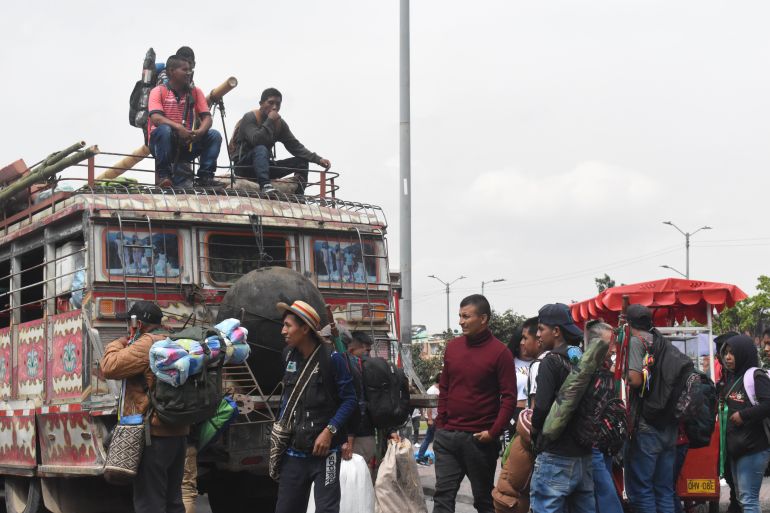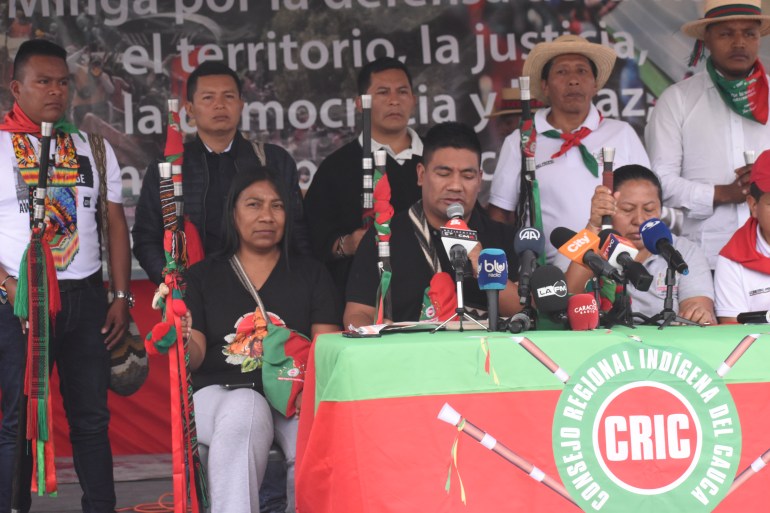Indigenous people march on Bogota to demand justice for killings
Indigenous ‘Minga’ collective demands action to stem a rising wave of violence in their communities across Colombia.

Bogota, Colombia – Thousands of Indigenous protesters have converged on Tercer Milenio Park in the heart of the Colombian capital, with music playing and smoke from campfires wafting through the air.
Members of the so-called “Minga” – a collective movement of Indigenous peoples – have organised protests in Bogota many times before, but this is their first demonstration during the administration of left-wing President Gustavo Petro.
Keep reading
list of 3 items‘Illegal operations disguised as tourism’: Colombia’s ‘VIP’ migrant routes
The secret to Colombia’s drop in deforestation? Armed groups
This week, they travelled with a simple – albeit pressing – demand: end an ongoing wave of violence that has disproportionately affected Indigenous people in Colombia, whose communities stretch across nearly every region, from Narino to Amazonia.
Ahead of the main protest march on Wednesday, demonstrator Viviana Guerrera said while she supported Petro in last year’s elections, she felt “extremely disappointed” by a lack of progress in curtailing violence in her home region of Cauca, which has long been a focal point of conflict.
“Every government needs to be held accountable,” Guerrera, a member of the Nasa Indigenous community, told Al Jazeera from the park, where organisers on Tuesday estimated that more than 12,000 people had already gathered.
“This government is no exception.”
Ongoing violence
Petro, who took office in August 2022, has promised to pursue what he calls “total peace” in a country that is still grappling with the effects of nearly six decades of internal armed conflict.
His plan, which involves both military action and direct negotiations with criminal armed groups, has so far yielded mixed results.
A six-month ceasefire with the largest remaining rebel group in Colombia, the National Liberation Army (ELN), which was celebrated as a political victory in August, has so far held.
But a number of informal ceasefires with other armed groups this year have since collapsed, and violence in rural areas has largely continued unabated.
The Global Witness advocacy group recently designated Colombia as the most dangerous country in the world for land defenders and environmental activists last year – and a disproportionate number of those targeted leaders come from Indigenous communities.
According to statistics from the United Nations Office for the Coordination of Humanitarian Affairs (OCHA), more than 37,000 people across the country were affected by violence between January and September of this year.
More than 43,000 others also were displaced by threats from armed groups or open fighting, the UN agency found. Colombian human rights watchdog Indepaz puts the displacement figure at more than twice that.
However, both organisations agree that Indigenous communities make up roughly half of all those displaced or affected by the violence, despite representing just 3.5 percent of the population.

The Regional Indigenous Council of Cauca (CRIC), one of the groups that organised the Minga, has called for an “Indigenous, social and popular struggle” against what it described as a “constant violation of human rights” and the killings of Indigenous and social leaders.
“We have come to work, in a grand assembly, to support this government in ‘total peace’ and form a pact to stop war and bloodshed,” Joe Sauco, a senior representative of the CRIC, said during a news conference on Tuesday.
“We want to support a way out of this tragic situation that rejects violence.”
Broken promises
The mood in Tercer Milenio Park has been festive, with children running through the area.
Members of Colombia’s Indigenous Guard, an unarmed security force that often confronts armed groups operating near Indigenous communities, also stood watch at the main entrance in the middle of downtown Bogota on Tuesday.
The march on Wednesday is set to coincide with street demonstrations called by Petro in support of a number of his reform bills, which have largely stalled in Congress. Some leaders at the Minga publicly called for support for the president’s administration.
But Eduardo Rojas, who travelled 14 hours by bus from Amazonia to participate in the rally, denounced what he said were false promises from Petro.
“We elected this government,” he told Al Jazeera, referring to the overwhelming support Petro’s presidential campaign enjoyed amongst Indigenous voters. “But what we were sold, and the reality of what we got, are two very different things.”
Rojas said his community in the region of central Amazonia has seen little progress in halting attacks from criminal armed groups, which he said forcibly recruit members and commit extortion and sexual violence.
Still, he said the Minga’s reception in the capital this year was different from past editions. “I have attended dozens of Mingas since my first as a young man in 1971,” he said. “And we were often perceived as invaders by the national government.
“As always, this time we have come in peace. I feel that this government knows that.”
‘Logistical and social challenge’
Elizabeth Dickinson, a senior Andes analyst at the International Crisis Group think-tank, said the frustrations expressed by Rojas are far from uncommon among Indigenous people in Colombia.
She attributed it, in part, to a lack of communication between the federal government and civil society. “The way that ‘total peace’ has been rolled out has been very top down,” Dickinson told Al Jazeera.
“And in some ways this hasn’t had much direct impact on rural communities. Implementing security programmes in these regions is also a huge logistical and social challenge.”
Dickinson also said that there have been missteps. “It was a strategic mistake for the government to grant broad ceasefires earlier this year without serious concessions from armed groups,” she said.
“And criminal organisations took advantage of this by digging in and fortifying their presence rather than disarming.”
Nonetheless, for Rojas, this week’s march is a chance to focus public attention in Colombia on the violence faced by Indigenous communities. “The government must deliver what it promised,” he said. “And I will keep attending Mingas until they do.”